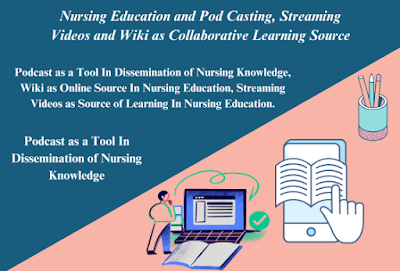The Pod Casting Streaming Videos and Wiki as Collaborative Learning Source In Nursing Education. Collaborative Learning Source In Nursing In modern nursing education, technology plays a significant role in shaping learning experiences.
The Pod Casting Streaming Videos and Wiki as Collaborative Learning Source In Nursing Education
Podcasts, streaming videos, and wikis have become invaluable resources for educators and students alike. These tools enhance the learning process by offering flexibility, interactivity, and engagement.
Podcasts, streaming videos, and wikis can be powerful tools for collaborative learning in nursing education, offering a variety of opportunities to engage students, share knowledge, and promote teamwork. Podcasts enable flexible, asynchronous learning through audio or video recordings, while streaming videos provide visual demonstrations and interactive learning experiences. Wikis, on the other hand, facilitate collaborative content creation and knowledge sharing by allowing students to contribute to a shared resource.
Podcasting as a Tool in Disseminating Nursing Knowledge
Podcasts are an increasingly popular method for sharing nursing knowledge. These compressed audio files, often in mp3 format, can be distributed over the Internet and easily accessed on smartphones, tablets, or computers. They provide a flexible way for students to consume educational content, such as lectures, case studies, or expert interviews, at their convenience.
Benefits of Podcasts in Nursing Education:
- Convenience and Accessibility: Students can listen to podcasts anytime, whether commuting, exercising, or during other activities.
- Enhanced Learning: Listening to recorded lectures or discussions allows students to revisit and review material, reinforcing their understanding and retention of complex concepts.
- Supplementary Learning: Podcasts can complement traditional classroom learning by covering additional case studies, clinical tasks, or nursing procedures.
- Flipped Classroom Strategy: Faculty can use podcasts to provide pre-class material, enabling students to come prepared for more interactive and discussion-driven sessions.
Creating podcasts is relatively simple and can be done using built-in software on laptops or specialized mp3 recorders for higher-quality sound. Distribution can be public (via streaming platforms) or private (through Learning Management Systems or LMS).
Wikis as Collaborative Learning Tools in Nursing Education
A wiki is an online platform where users can collaboratively create, edit, and share documents. It fosters teamwork and collective knowledge-building, making it a valuable tool in nursing education. Unlike static resources, wikis can be constantly updated, ensuring content remains current and accurate.
Uses of Wikis in Nursing Education:
- Collaborative Assignments: Students can work together to create wikis on topics like nursing history, care plans, or ethical issues. This collaboration promotes critical thinking and research skills.
- Crowdsourced Learning: Wikis allow students to contribute to and refine content, leading to a deeper understanding of the subject matter.
- Dynamic Study Guides: Nursing students can create and maintain study guides, FAQ sections, and resources for clinical placements, benefiting both current and future cohorts.
- Peer Review: Wikis encourage students to critique and improve each other’s work, fostering a collaborative learning environment.
Private wikis embedded within LMS platforms ensure that the learning environment is controlled and conducive to high-quality contributions.
Streaming Videos as Learning Resources in Nursing Education
Streaming videos are highly effective in nursing education, offering dynamic visuals to explain procedures, demonstrate psychomotor skills, or convey complex patient care scenarios. Unlike traditional DVDs or Blu-rays, streaming videos are easily accessible, don’t require physical media, and can be played on demand.
Benefits of Streaming Videos:
- Engagement and Interaction: Videos engage students more effectively by bringing real-world nursing scenarios to life, encouraging empathy and critical thinking.
- Learning Across Domains: Videos enhance learning in cognitive, psychomotor, and affective domains. For example, they can demonstrate the steps of a medical procedure or showcase a patient’s emotional journey.
- Flexibility: Streaming platforms like YouTube, Vimeo, and dedicated nursing education video providers offer a wide range of educational videos that can be integrated into lectures or watched independently.
However, reliance on Internet access can be a drawback. To mitigate this, some streaming platforms offer download options for offline viewing.
Conclusion
Podcasts, wikis, and streaming videos are transforming nursing education, making learning more accessible, interactive, and engaging. These tools allow nursing students to learn at their own pace, collaborate with peers, and gain practical insights from real-world scenarios. By integrating these technologies into the curriculum, nursing educators can better prepare students for the challenges and opportunities of modern healthcare.
FAQs
Q: How can podcasts benefit nursing students?
A: Podcasts provide flexible learning opportunities, allowing students to listen to lectures, discussions, and case studies anytime. They also serve as a useful tool for revisiting complex material.
Q: Why are wikis valuable in nursing education?
A: Wikis promote collaboration, critical thinking, and peer review. Students can create, edit, and update nursing-related content, enhancing both individual and group learning experiences.
Q: How do streaming videos enhance nursing education?
A: Streaming videos offer dynamic visuals to teach psychomotor skills, clinical procedures, and patient care scenarios. They help engage students across various learning domains and can be accessed on-demand.
Q: What challenges exist when using streaming videos?
A: The primary challenge is the reliance on stable Internet access. Some platforms allow videos to be downloaded for offline use, addressing this limitation.
Q: How do these tools prepare nursing students for the workforce?
A: These tools provide real-world insights, enhance collaborative skills, and promote flexible learning, all of which are crucial in preparing nursing students for the fast-paced, evolving healthcare environment.
Read More:
https://nurseseducator.com/didactic-and-dialectic-teaching-rationale-for-team-based-learning/
https://nurseseducator.com/high-fidelity-simulation-use-in-nursing-education/
First NCLEX Exam Center In Pakistan From Lahore (Mall of Lahore) to the Global Nursing
Categories of Journals: W, X, Y and Z Category Journal In Nursing Education
AI in Healthcare Content Creation: A Double-Edged Sword and Scary
Social Links:
https://www.facebook.com/nurseseducator/
https://www.instagram.com/nurseseducator/
https://www.pinterest.com/NursesEducator/
https://www.linkedin.com/in/nurseseducator/
https://www.researchgate.net/profile/Afza-Lal-Din
https://scholar.google.com/citations?hl=en&user=F0XY9vQAAAAJ

I’m extremely impressed along with your writing talents and also with the structure on your blog. Is that this a paid subject or did you customize it your self? Anyway stay up the excellent high quality writing, it’s rare to peer a great blog like this one nowadays!